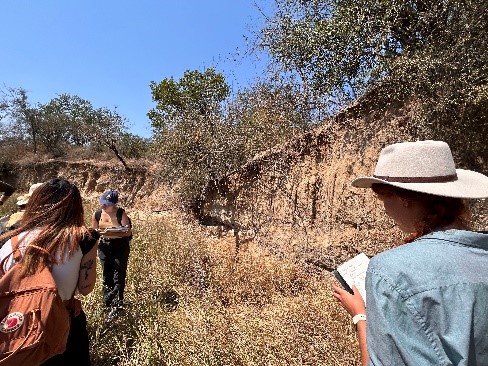South African Adventure
In September, our third-year students embarked on a trip to South Africa as part of the Savannah Ecology module. We caught up with Mia a third-year biology student who reflected on her experience and time out in the field.

Students out in the field.
The Savannah Ecology (BIO392) module is offered to third year students studying Zoology, Biology or Environmental Science and runs in September ahead of the first semester. On this module you create your own research projects, take part in lectures from experts in their field, as well as experience nature and wildlife up close from living on a campus without animal controls. The module runs for two weeks out of the Wits Rural Facility, with visits to the Drakensburg mountains and Kruger National Park. It’s an incredible experience allowing students to take independence on their own research through personal reflection of observations made, while keeping a field book of the work completed across the few weeks.
The South Africa trip is varied and well-paced, with the start of the week being filled with briefings and tours of the reserve. We were introduced to the site with several walks from the academics, focusing on what we could see and learn from scat and tracks. Then over the first few days, we completed workshops learning about the habitats and animals we were likely to see. We got the experience to try two guided experiments, laying camera traps around the site and making and placing plasticine caterpillars around the reserve. Reviewing the results was exciting, with many people capturing footage of the hyenas, zebras and giraffe that live on the reserve. Our visit to the Drakensberg peaks was a lovely day trip, where we tested a hypothesis and lay a series of transect lines and quadrats studying the plant diversity and distribution from the edge of the cliff. The highlight of the trip is the two days we spent exploring Kruger National Park. During this time, we are split into mini vans of around 7 people and one academic where we spent the days eagerly looking at the windows and chasing sightings that other cars had seen!
This trip was such an incredible experience, not only for the independence and control we had managing our own research and setting ourselves up for our final year, but the undiluted access we had to our academics. Travelling with five of Queen Mary’s top lecturers and researchers gave us a unique experience to discuss more than just the module and learn a lot from them about their research and academic journeys. I know the hands-on approach has inspired lots of students, and new relationships have been formed between QMUL and Kruger Park, which gives way for exciting opportunities in the future that have been nurtured from this trip.
During the two weeks we experienced some incredible interactions with the wildlife. On one occasion when returning to our bush camp, I was informed that the pair of giraffes had just passed through! This was the first time they had been properly sighted, so a friend and I spent around 15 minutes following their tracks into the bush. It was exhilarating tracking them using the techniques we’d been taught, and when we finally caught up we were able to stand admire them completely on our own. It was moments like these we realised were so unique, to observe these incredible creatures in their natural habitat was a moving experience.
One of the highlights of having the academics with us was that the experts in their fields were incredible at spotting things we couldn’t! We went on a night walk with Patrick Hennessey, a herpetologist, a small group of us with some head torches and a ultraviolet torch and ventured to find some interesting things in the bush that we are only able to find at night. Our first encounter was with a small scorpion on the path, which Patrick explained has a bioluminescent exoskeleton – as shown by the glow from the ultraviolet torch light! Next, with a keen eye from our academic, we were able to find several chameleons who were very grumpy about being disturbed but incredible to see up close.